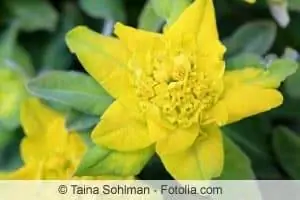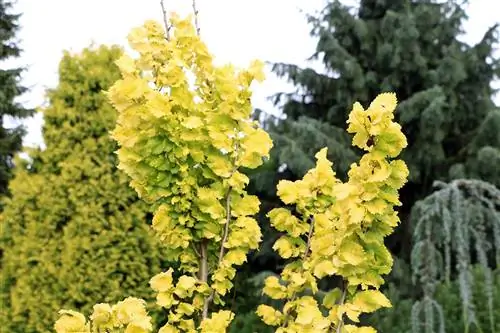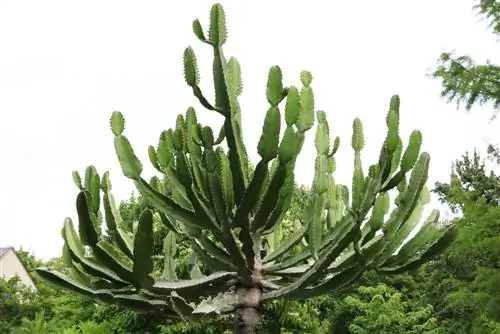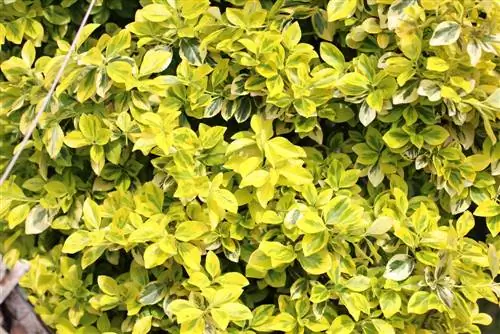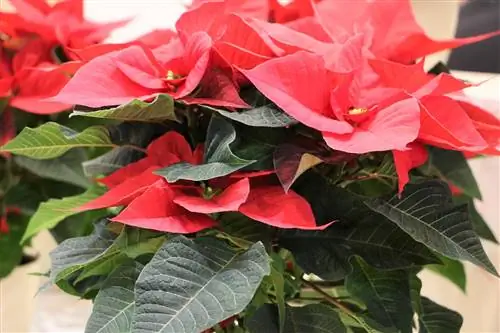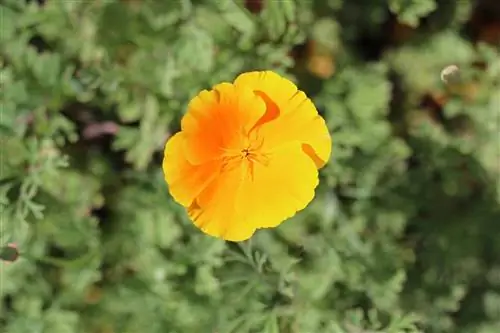- Author admin [email protected].
- Public 2023-12-17 03:39.
- Last modified 2025-01-24 12:45.
Gold spurge is characterized by its hemispherical growth and reaches a height of up to 50 cm. Thanks to the golden yellow bracts and the copper-colored autumn color, this spurge plant looks particularly attractive. The plant is hardy and also fits in a normal bed. Since care is very easy and golden spurge is resistant to many pests, this garden plant poses little concern for a gardening lover.
Gold spurge can be used in many garden areas such as woodland edges or rock gardens. It is also ideal for green roofs and natural slope planting.
Care
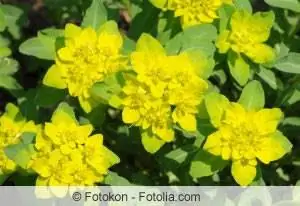
Golden spurge feels particularly comfortable in the sun, but also thrives in partial shade. This spurge plant comes into its own very well in small groups or tuffs of three to ten plants. Normally it is not necessary to water the plant as rain is completely sufficient. Golden spurge prefers well-drained and dry soil. It thrives particularly well in alkaline soil conditions. If additional watering is necessary, only a small amount of water should be used. It is also important to ensure that no waterlogging occurs. To stimulate the plant's growth and provide it with additional nutrients, you can use cactus fertilizer. Golden spurge is rarely attacked by pests and is also known as the “slug repellent” because it is generally avoided by these voracious garden inhabitants.
Tip:
Golden spurge can release a poisonous, milk-like substance. Therefore, you should always wear gloves when gardening.
In addition, it is important to ensure that small children and pets stay away from the plant.
Wintering
Golden spurge is conditionally hardy. To ensure that this plant survives the cold season well, it is covered with fir or leaf branches before the first frost. If they are uncovered again in time in early spring, it is not possible for rot to occur. Additionally, care must be taken to protect golden spurge from the winter sun. When exposed to sunlight, it evaporates more moisture than it can extract from frozen ground. Therefore this measure is necessary. To guarantee sufficient shade, just a few pine fronds are enough. They are spread over the plant or stuck into the ground.
Plants
Most often, golden spurge propagates by self-seeding. If you want to propagate them specifically, there are various options. Particularly simple methods that hobby gardeners can carry out relatively quickly are division and top cuttings. If you decide to sow, the preparation is a little more complicated. You should not plant golden spurge in depressions. There is a risk of rot developing in these areas.
Head cuttings
In spring or summer you can cut top cuttings with a sharp knife. It is important to wear safety glasses and gloves during this process. So that the cuttings dry at the interface, they are left for a few days. They are then placed in the loosened potting soil at a selected location and lightly watered.
Sowing
If you decide to propagate by sowing, you should pay attention to controlled conditions. It is not recommended that sowing takes place directly in the bed. The reason is that the seeds dry out very quickly. They are also often eaten by snails, birds or other animals. Since spurge plants are cold germinators, they can be sown very early in the year. The seeds can be stored at a maximum temperature of 5 to 10 °C until germination. Experienced hobby gardeners place them in a plastic bag filled with a growing medium or moist sand. This bag is stored in the refrigerator, but should under no circumstances be placed in a freezer or freezer compartment. During this time you must ensure that the potting soil does not dry out and remains slightly moist at all times. If the substrate dries out completely, there is no possibility of germination. As soon as the first leaves appear, the seedlings can be pricked out, placed in nursery pots and brought outdoors. They will continue to develop over the next few weeks.
Division
In addition to top cuttings and sowing, there is also the option of propagating golden spurge by division. To do this, carefully dig up the root ball of the spurge. It is then divided with a knife or by hand. You should be careful not to injure the roots unnecessarily. It is important to select rooted sections. This allows them to grow faster in a new location.
Frequently asked questions
Is golden spurge suitable for every soil type?
Basically, golden spurge does not place high demands on soil quality and can therefore be used in a variety of ways. Nevertheless, you should make sure that the soil is permeable and dry. The plant thrives particularly well in calcareous soil.
How often should you water golden spurge?
Most of the time it is not necessary to water this plant. Rain is completely sufficient. Otherwise, you should water very sparingly and definitely avoid waterlogging.
Is golden spurge hardy?
Yes. Golden spurge can survive the cold season in the garden unscathed. However, some precautions must be taken for overwintering so that the plant shines again in full splendor in spring.
Is golden spurge poisonous?
The plant can release a white, poisonous liquid that resembles milk in appearance. Therefore, you should always wear gloves when caring for and cutting. It is recommended to keep small children and pets away from the plant.
Which garden areas is golden spurge suitable for?
Gold spurge can be used in many ways in the garden and is ideal for beds, rockeries and also for creative green roofs.
What do you have to consider when planting?
Golden spurge mostly reproduces by self-seeding. There are various planting methods available to a hobby gardener. The division is relatively simple. Planting head cuttings is also easy. Gardeners who have more experience may also choose to sow seeds. The preferred planting time is from spring to summer.
What you should know about golden spurge soon
Profile
- Flowering time: May to June with green-yellow small inconspicuous flowers in bright yellow bracts sitting in umbrella-shaped inflorescences
- Note: Bracts are often mistakenly referred to as flowers and remain colorful with enormous luminosity throughout the summer
- Foliage: egg-shaped, dark green, softly hairy leaves with striking red autumn color and mostly reddish shoots
- Growth: clump-like, strongly branched growth with cushion-like spread over the branched rhizome
- Height: Golden spurge reaches 30 to 50 cm
- Location: sunny, warm, also in front of south-facing walls; also tolerates partial shade, although full sun is preferred; water-permeable, nutrient-rich, calcareous, moderately dry soil
Plant and care
- Planting time: can be sown in spring or autumn
- Neighborhood: fits well on gravel areas and as a border plant on paths
- Pruning: Pruning in late autumn or early spring before new growth
- Propagation: Division in spring after flowering (see propagation below), can also be sown in spring
- Care: Watering not necessary, rain is usually enough.
- Fertilization: Leave fallen leaves lying around, they are processed into humus by soil organisms, then no fertilization is necessary
- Wintering: hardy
- Special features: even the smallest injuries to the plant release a toxic, skin-irritating milky sap that can be dangerous for children and pets
Known variety
'Purpurea': interesting contrast between yellow bracts and reddish leaves
Propagation
- Cut leaves and keep the fresh cut and lukewarm water to stop the milk flow.
- Then let it dry for at least a few hours or days so that they don't rot in the ground later.
- Then they are placed in potting soil with the shortened stem.

